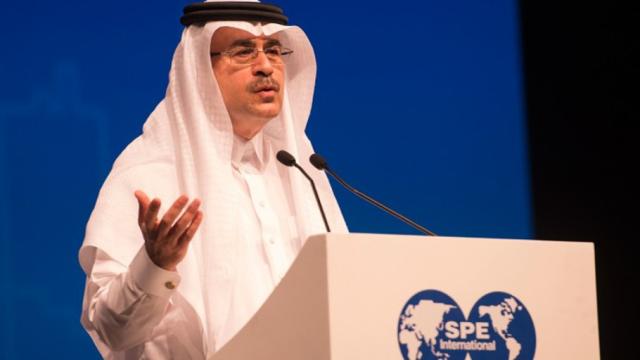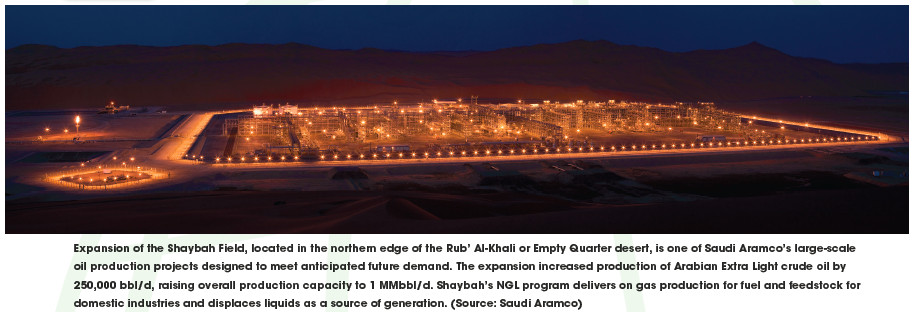
Nasser gave the opening ceremony keynote speech at the September SPE meeting in Dubai. (Source: Saudi Aramco)
At the recent Society of Petroleum Engineers (SPE) Annual Technical Conference and Exhibition 2016, Amin H. Nasser, president and CEO of Saudi Aramco, gave the opening ceremony keynote speech in which he discussed his vision for a transformed industry. This is an excerpt of that speech.
Present scenario
Let’s first recap the energy landscape. World demand is on a steady, if moderate, course.
While its pace has been tempered by energy efficiency gains, demand will be impacted by global population growth expected to pass 9.5 billion by 2050, and rising living standards in developing economies. Meanwhile, alternative energy sources are gaining ground.
Yet renewables and emerging technologies like electric vehicles and fuel cells have technical, economic and infrastructure hurdles to pass. And that takes time.
So for years to come, the call on energy will be met by oil and gas, and oil’s central position, especially in heavy transport and petrochemicals feedstock, will remain solid. But the oil and gas resources we have available, as well as new discoveries, are more challenging and more expensive to develop. At the same time, the present oil and gas fields are becoming increasingly mature and complex to operate.
Environmental pressures are intensifying amid misperceptions about our support of a cleaner environment. While the oil market has recovered from its most severe period, it’s still weak.
With investments into new oil and gas capacity being cancelled and deferred around the world, supply growth has started falling, especially U.S. shale oil.
Despite volatility, the market is heading toward rebalance, and prices are likely to strengthen with time. However, market volatility could remain with us for the near future.
In light of this backdrop, I’d say the industry’s present business and operating model is not up to the tasks ahead. I’d like to discuss an integrated four-point framework that can stand up to the energy transitions; policy, environmental and regulatory trends; rising complexity of operations; and other variables at play.

Resilience
The first point on our new business model is resilience. Unprecedented pressures face the industry in this persistent low oil price environment, especially in terms of finances, cost and technology. As we see in the financial arena, companies with weak finances are facing serious difficulties, especially those that are smaller and overleveraged. Strong financial capacity to pass through difficult patches is clearly important to future resilience.
As it stands, $1 trillion in costly, challenging and marginal resources may be delayed or canceled by the end of this decade. Yet long-term investments must be maintained to develop new capacity and keep technology on track. And that’s where greater efficiency and cost competitiveness come in: spotlighting things we can do better and cheaper without compromise on safety or the environment.
Research and high-end technology
Innovation has always been the upstream sector’s driving force, an area no one knows better than the SPE. In recent years, we have seen it take E&P to epic proportions:
- Opening new sources of hydrocarbon supply such as shale oil and gas;
- Making exploration more effective and improving recovery factors;
- Lightening our carbon footprint;
- Increasing profitability; and
- Broadly expanding our knowledge and capabilities.
Clearly innovation can’t stand still, but it can’t plod along, either. We have to push the envelope.
Saudi Aramco is doing just that as part of our strategic intent to become a global integrated energy and chemicals company. We’re using an ‘open innovation model’ to pursue R&D that complements our in-house resources by three other major vehicles. The first is strategic alliances with academic institutions, service companies and technology developers. Second, we have a total of 11 satellite research centers and technology offices on three continents, giving us access to world-class talent and expertise in all corners of the world. And the third is the use of venture capital through our subsidiary, Saudi Aramco Energy Ventures, which invests in cutting-edge technology startups.
We’re also leveraging technology to increase recovery in our oil reservoirs from the current average of 50% to 70% and improve exploration to take our resource base to 900 Bbbl.
Top-notch talent
But investing in technology and research to solve E&P’s big challenges also calls for investing in the people who will develop and use these tools. The alternative—putting the recruitment, development and retention of top talent on the back burner during a downcycle—will only come back to haunt us. Now is the time to reboot our approach to human resources [HR].
Thanks to technology, the deep functional expertise of the past has given way to multidisciplinary skills for cross-functional challenges. And the learning curve for staying on top of new technologies, methods and standards is getting shorter.
I’d like to highlight some talent solutions we’re implementing at Saudi Aramco. To switch gears from traditional training to a more immersive, hands-on approach, we developed our Upstream Professional Development Center. The center helps to compress the time for newer engineers and geoscientists to hit the ground running while capturing the knowledge and experience of more senior professionals.
In another paradigm shift, King Fahd University of Petroleum and Minerals collaborated with us to establish its new College of Petroleum Engineering and Geosciences. This pioneering college seeks the best undergraduate and graduate students to pursue state-of-the-art studies and research in a creative, multidisciplinary environment that integrates classroom, lab and field. Students are challenged to achieve stretch targets with the overall objective of maximizing discovery and recovery of hydrocarbon resources. Its first cohort of students graduated last spring, and we expect research-oriented Ph.D. enrollment to grow tenfold.
Another urgent HR challenge facing the industry is bringing more women into the upstream.
Increasing women’s representation is a big focus for Saudi Aramco, in our company but also through programs that develop their business potential in general. This diversity objective especially resonates in the Kingdom, where women are highly educated but underrepresented in the workforce.
Collaboration
The first three aspects of industry transformation through a new model converge in point No. 4.
And that’s collaboration. As oil companies, service providers, technology developers, higher education and others come together in strategic cooperation, it’s clear: Resilience, technology and talent integrate and overlap. There are many areas in which the industry’s interests are aligned, and collaboration can pool resources, spread costs and enhance the chances of success.
Enhancing our industry’s reputation is one such area where we have been historically lacking.
Partners can help tell our story and shed new light on our strides in sustainability.
A recent example is the industry’s joint efforts to highlight its role in reducing carbon emissions and conventional pollutants, notably the Oil and Gas Climate Initiative declaration. Another area where collaboration can make a big difference is for oil companies, contractors and service companies to radically improve project designs and cut costs. Evolving energy and environmental policies and creating a level playing field among various energy sources are also potential topics for strategic cooperation.
Transformation needed
Our sector is undergoing dramatic, complex shifts like never before. Merely adapting or reacting to change is only a stop-gap. These dynamics call for us to transform through a holistic process that spans every dimension, from technology and operations to HR and organization.
In my view, the new business model I’ve sketched out in part today [Sept. 26] can help us meet the challenges ahead, with:
- Greater resilience through better financial management, improved project designs, major cost reductions and other efficiencies;
- Research, technology and talent as our long-term success drivers; and
- Cooperation that multiplies strengths and resources toward mutual goals.
And to strengthen the new model, we as an industry can work more closely with SPE both as a platform for discussion and a catalyst for action. Innovating our business model in this way can deliver the reinvention needed in disruptive times and position us even better for the recovery.
Nasser’s full speech can be accessed at Saudi Aramco’s website.
Recommended Reading
Infinium, Summit Carbon Solutions Join Forces to Advance Efuels
2025-02-05 - Infinium will supply up to 670,000 metric tons of CO2 to Summit Carbon at a eFuels facility.
CS Energy, Calibrant Deliver Three BESS in New York
2025-02-05 - CS Energy and Calibrant Energy completed three stand-alone battery energy storage systems in New York.
Sage Geothermal, ABB Form Energy Storage, Power Partnership
2025-02-04 - In a memorandum of understanding, ABB said it would support Sage Geothermal on its energy project with Meta.
EDP Renewables Secures Land for Energy Storage Project in Canada
2025-02-04 - The energy storage project is scheduled to begin commercial operation in 2027, EDP Renewables says.
Comments
Add new comment
This conversation is moderated according to Hart Energy community rules. Please read the rules before joining the discussion. If you’re experiencing any technical problems, please contact our customer care team.




